Dental Implants – San Antonio, TX
The Ultimate Way to Replace Missing Teeth

Dental implants have become more and more popular in recent times, with 500,000 implants being placed each year. Many dentists have even started to call them the new gold standard for replacing teeth. This is because even though traditional dentures and bridges still have their merits, dental implants remain the only solution that allows us to replace the roots of the teeth along with the crowns. Interested in filling the gaps in your smile or upgrading your dentures with dental implants? Call today to schedule a consultation with Dr. Patel to discuss tooth replacement with dental implants in San Antonio, TX.
Why Choose HIC Dental - Implant & Family Dentistry for Dental Implants?
- Placement and Restoration Under One Roof
- Homey Dental Office with Convenient Hours
- We Value Honesty, Integrity, and Compassion
What are Dental Implants?

Dental implants are made up of three parts:
- A post made out of titanium or another biocompatible material designed to be placed in the jawbone
- A restoration (e.g., a crown, bridge, or denture) that is made to look and act like your natural teeth
- A metal abutment that attaches the restoration to the post
The post fuses with the jawbone, letting it act like a new tooth root. Once the restoration is in place, you’ll have long-lasting new teeth that look and feel incredibly natural.
The 4-Step Dental Implant Process

We don’t have to refer you to an outside specialist to have your dental implants placed. Every step of the process can be completed right here at our San Antonio practice. Each patient is different, so your journey towards a complete smile won’t be exactly the same as someone else’s. However, you can generally expect the implant process to follow four basic steps, as outlined below.
Initial Dental Implant Consultation

First, you must determine whether dental implants are your best choice for replacing your teeth. To do this, you’ll need to schedule a consultation at our office. We’ll carefully examine your mouth and facial structures to determine your candidacy for the procedure. Sometimes we may have to schedule preparatory treatments before moving on to the next step. For example, patients who don’t currently have enough jawbone density to support implant posts might require bone grafts.
Dental Implant Surgery

Once we’re sure that your mouth is ready, we can move forward with implant surgery. We start by numbing your mouth before making a small incision in your gums. Then, we insert the implant posts into your jaw at carefully chosen locations. Your gums will be sutured shut afterward, and we’ll need to place a small protective cap over each implant post to ensure a smooth healing process.
Dental Implant Osseointegration & Abutment

Osseointegration is a natural process where your dental implants fuse with the jawbone. This is what allows your implant posts to fulfill the same functions as natural tooth roots. The exact timeline for osseointegration is different for everybody; it depends on several factors such as the location of the implants and the health of the jawbone. Usually, though, you can expect it to take around 3 to 6 months.
After successful osseointegration, you will return to our office to receive your abutments. An abutment is a small metal connector piece that is attached to an implant post. It is what we’ll use to secure your restoration in place during the final step of the implant process.
Delivery of Dental Implant Restoration(s)

We’ll wait until your mouth has fully healed from the previous steps before we start the process of designing your final restoration. We will take an impression of your mouth with the dental implants and abutments in place. The impression will be sent to a dental lab, where it will be used to design a crown, bridge, or denture that will look natural alongside the rest of your smile.
The completed final restoration will be sent to our lab. At that point, we will schedule one last appointment so that you can receive your new teeth. Before we place the restoration, we may need to make some last-minute adjustments so that it fits properly and blends in with the other teeth. Once everything is ready, we will attach the restoration to the abutments, and you’ll be able to start enjoying your new teeth!
Benefits of Dental Implants
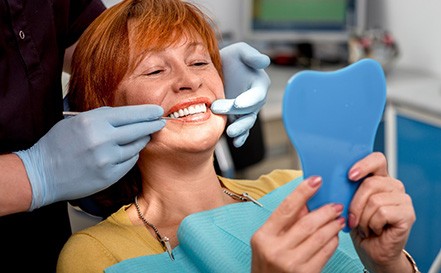
Dental implants are becoming one of the most popular ways to replace missing teeth. In fact, it’s already to the point that over 500,000 of them are placed every year! This popularity, it seems, stems from how these restorations provide benefits that you can’t get from dentures or bridges. Unlike the latter, implants have unique features due to fusing with the jawbone. Consequently, they can dramatically improve your confidence, health, and quality of life.
If you’d like to learn more, keep reading or contact our office for details!
Day-to-Day Benefits

Artificial or not, teeth are necessary for various basic, everyday tasks. The most noticeable implant benefits are, then, the day-to-day ones that improve daily life. Once placed, your new restorations will almost immediately offer perks like the following:
- Greater Chewing Ability – Implants become part of your jaw, restoring more of your chewing ability than other replacement options. Therefore, they’re durable and robust enough to help you chew your favorite foods. Better yet, they do so without the risk of slipping or falling from your mouth!
- A Boost in Confidence – Thanks to their lifelike porcelain, implants blend seamlessly with your other teeth. They thus make your smile full and beautiful, boosting your confidence and body image as a result.
- Easy Maintenance – In truth, you can care for dental implants just as you do your natural teeth. More specifically, you only need to brush them twice daily, floss them once daily, and rinse them with mouthwash. Otherwise, just remember your regular dental checkups — they’ll give your dentist a chance to diagnose and treat implant threats early.
Health Benefits

Besides their immediate cosmetic advantages, implants also positively change your health. Such changes include:
- A Strong/Healthy Jaw – Unless treated, tooth loss causes your jawbone to erode over time. Implants, however, stop this process by stimulating your jaw’s bone tissue. In other words, the restorations keep your jawbone strong and healthy.
- Protection for Natural Teeth – When you have missing teeth, your remaining ones will tilt toward the gaps in your smile. Thankfully, implants keep that from happening, so your pearly whites stay straight and aligned.
- Improved Nutrition – Unfortunately, tooth loss can lead people to eat restricted diets due to chewing problems. Since implants restore bite force, though, they let you eat a wider variety of foods that boost your nutritional health.
Long-term Benefits

Last but certainly not least, you’ll likely recognize implants’ long-term benefits. The most common of these are:
- Highly Successful – Implant placement almost always succeeds in the long run. Studies even show that its success stays at 95% over ten years after treatment!
- Long-Lasting Results – On average, dental implants last 15-20 years. With proper care, implant lifespan can even reach 30 years or more!
- Cost-Effectiveness – Unlike dentures or bridges, implants often don’t need replacement — they can last you a lifetime! For that reason, they tend to save patients more time and money than other options.
Who Dental Implants Can Help

Are you missing at least one tooth? Are your gums healthy? Is your body in good enough shape for surgery? Can you commit to a process that lasts several months? Is there still plenty of bone in your jaw? If you can answer “yes” to all these questions (or are willing to have bone grafts and other treatments done to make implants a viable option), then you are likely a good candidate for one of the following implant procedures.
Missing Single Tooth
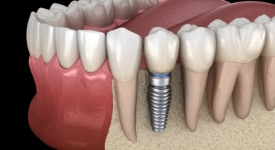
We only need to put a single implant in your jawbone. Once the area around it heals and the abutment is in place, we can start designing a beautiful dental crown that matches your natural teeth. Once it’s in place, it will look like you were never missing a tooth at all.
Missing Multiple Teeth
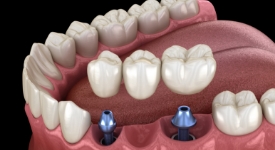
Dental bridges normally use natural teeth for support, but they can easily be attached to a pair of dental implants as well. This makes it possible to replace three to four teeth all at once without needing an implant post for each individual tooth. This approach also means we don’t have to make any alterations to your remaining teeth to place the bridge.
Missing All of Your Teeth
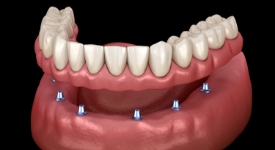
It takes fewer implants than you might think to replace an entire row of teeth. Oftentimes, a full denture can be supported by just four to six dental implant posts. Also, depending on your own preferences or your health needs, we can design an implant denture to be removable or fixed.
Learn More About All-on-4 Learn More About Implant Dentures
Understanding the Cost of Dental Implants

You won’t know exactly how much your implants will cost until you’ve had a consultation at our dental office. We’ll explain how preliminary treatments, the number of implants that need to be placed, the kind of restoration that will be used, and other factors will influence the final price. We want you to feel confident in your choice, so you’ll always know an estimate of the cost of your treatment before we begin. To learn more the cost of dental implants in San Antonio, keep reading below.
Preliminary Treatments & Dental Implant Surgery
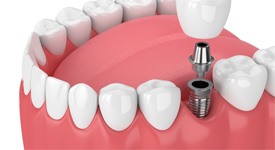
After carefully examining your mouth, Dr. Patel – an experienced implant dentist in San Antonio – may determine that you need preliminary treatment before getting dental implants. Preliminary treatments like gum disease therapy, tooth extractions, or bone grafting will add to the overall cost of your treatment. However, they are vital for ensuring the success of your new smile.
Implant surgery incurs its own cost, including where the implants are being placed in the jaw and what kind of sedation or anesthesia you need. Dr. Patel performs start-to-finish implant treatment right here at HIC Dental, which means you won’t have to worry about working with an outside oral surgeon and paying a separate fee for implant surgery.
The Parts of Your Dental Implant

The different parts of dental implants in San Antonio affect the final cost:
- Number of Dental Implants – One implant versus 4-6 implants for an implant denture.
- Type of Restoration – Crowns, bridges, dentures each cost different amounts.
- Size or Material – Implants are often made longer or shorter depending on the placement and the patient’s jawbone; some are made of zirconia instead of titanium.
- Brand of Dental Implant – Different manufacturers make dental implants differently to cater to unique needs of certain patients.
How Dental Implants Pay for Themselves
Many patients are tempted to choose dentures or dental bridges over implants because of their lower initial price. However, when comparing the cost of implants to other tooth replacements, remember that implants have a number of benefits that you wouldn’t get with other restorations. For example, dental implants don’t wear down teeth or irritate gums and they’re easy to keep clean, which means they’ll help you prevent issues like gum disease, tooth decay, and jawbone deterioration, as well as the costs associated with treating them. Dental implants also last much longer than traditional dentures or dental bridges. With proper care, dental implants can last for 30 years or more! The long-lasting nature and other unique benefits of dental implants make them the smarter investment for many people.
Does My Dental Insurance Cover Dental Implants?

Most dental insurance plans do not cover the cost of dental implants in San Antonio. However, your insurance may cover a percentage of your final restoration or preliminary treatments. Because every insurance plan is slightly different, it’s important to confirm your coverage before beginning implant treatment. Our knowledgeable staff can help you understand the details of your insurance plan and maximize your benefits .
Making Dental Implants Affordable

Even if your dental insurance doesn’t cover implants, there are other ways to restore your smile in an affordable way. For example, you could take advantage of flexible financing through CareCredit. A trusted partner, CareCredit enables eligible patients to break up the cost of implant treatment into monthly installments instead of a single lump sum. Many CareCredit plans come with low or no interest, making them a great fit for almost any budget. Ask our team for more details!
Advanced Dental Implant Procedures

If you’re interested in a more comprehensive solution for replacing missing teeth, then dental implants may be the best treatment out there. Nearly all patients who are struggling with moderate to severe tooth loss may be eligible for this restoration option. That said, missing teeth can typically result in jawbone deterioration, which can cause some patients to not have the sufficient bone density to support the implants. The good news is that we can provide the necessary treatments to ensure a successful restoration treatment, such as bone grafting and ridge expansion. With these services, you’ll have a much more reliable foundation to secure your dental implants for several decades to a lifetime! Keep reading to learn more about these advanced dental implant procedures in San Antonio or reach out to us to schedule your appointment.
Why Jawbone Density Matters for Dental Implants
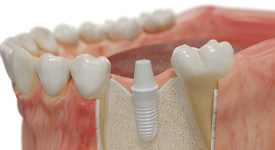
Have you been told that your jawbone doesn’t have enough density to support your metal implant? Even if you don’t feel like your jaw has deteriorated since losing any of your teeth, this can play a major role in the success of your restorations regardless. Your natural tooth roots typically stimulate blood flow in your jawbone, maintaining its strength and health. Once you lose pearly whites, the area will lack the proper blood flow, causing the jawbone to shrink or lose its structure.
Dental implants essentially serve as your new permanent roots, encouraging healthy circulation in the jawbone to promote healthy bone growth. For this to work, however, the implants will need to properly integrate with the existing bone tissue. If there isn’t a sufficient amount, there won’t be enough material for the metal posts to fuse with. Fortunately, we can offer treatments to help improve your jawbone density.
Bone Grafting

A bone graft is a minor oral surgical procedure where our team will use healthy bone tissue to help promote new jawbone tissue in a particular area. We’ll first gather the tissue from another part of your body or a donor. The grafting substance will then be placed into the area of the jawbone that needs to be strengthened. While the tissue integrates, it will promote improved natural bone growth in the place where the dental implant will be inserted. This process can typically take several months to complete, but it’s crucial for increasing the rate of dental implant success.
Ridge Expansion

A sinus lift is a certain kind of bone graft. The sinus cavity is located above your upper back molars. Once one of these teeth goes missing and the jawbone deteriorates, that side of the mouth might not be thick enough to hold a dental implant without it sticking into your sinuses. The sinus lift process consists of taking bone tissue from a donor or other part of your body and inserting it in the area that needs it. Our team will make a tiny window in your jawbone and carefully push up the membrane holding your sinuses. This new space will then be filled with grafting material, and the area will strengthen over the next few months.
Dental Implants Post-Op Instructions

What happens in the first few days after your dental implant surgery is crucial to the long-term success of your new teeth. As a Fellow of the International Congress of Oral Implantologists, Dr. Patel will place your implants with the utmost safety and precision. He’ll then provide you with some aftercare guidelines to ensure a smooth recovery that leads to a lasting smile. Below, you can find a handy outline of dental implants post-op instructions in San Antonio that you can reference during your recovery.
What to Do Directly After Dental Implant Surgery

Try to take it easy for the first 24 to 48 hours after your procedure. Strenuous physical exercise could impact your body’s healing rate. During this period, take all of the medications we have prescribed as directed. You should also avoid using a straw, spitting, rinsing forcefully, or blowing your nose. These activities could loosen the blood clot forming over the surgical site and cause the dreaded dry socket, which not only hurts but also delays the healing process.
Common Side Effects

Mild soreness and discomfort are both common side effects that can be managed with your prescribed pain medications as well as over-the-counter options. As with any form of oral surgery, facial swelling is common after dental implant placement, but this can be reduced with cold compresses. You may notice some light, intermittent bleeding from the implant site, particularly in the first day or two. Apply pressure with gauze pads to curb the blood flow. Be sure to call our office if bleeding continues even after applying pressure or if you feel severe discomfort after more than 72 hours.
Diet

While you’ll eventually be able to eat practically anything with dental implants in San Antonio, you should stick to a diet of liquid and soft foods following your surgery. After a week or so of healing, you can eventually add chewier foods as you feel more comfortable. Some excellent foods to eat during this time include:
- Mashed potatoes
- Yogurt
- Ice cream
- Pudding
- Smoothies (just don’t use a straw!)
- Cold, creamy soups
- Applesauce
- Soft-cooked pasta
Health & Oral Hygiene

Oral hygiene is incredibly important after dental implant surgery; failure to remove plaque and bacteria could cause an infection that results in implant failure. On the first day, avoid getting too close to the implant site when you brush and floss. After that, be gentle when cleaning the area. If we have prescribed a mouthwash for you to use, be sure to rinse with it as instructed (but don’t spit or rinse too forcefully).
What to Do After Your New Teeth Are Attached

Most patients feel back to normal after about a week after their dental implant surgery. A few months later, the implants should have fully integrated with your jawbone. At that point, your implant dentist in San Antonio will attach your dental crown, bridge, or denture to complete your smile. Your gums may feel slightly sore or sensitive for a day or two, but it’s nothing that over-the-counter pain reliever shouldn’t be able to manage.
Maintaining & Caring for Your Dental Implants

Dental implants can last for more than three decades or even the rest of your life. However, it is crucial that you take all the proper steps to care for them. If you aren’t taking precautions to protect your dental implants from becoming damaged, they could end up failing and needing to be replaced. The good news is that with just a few simple precautions, you can keep your implants healthy and enjoy their benefits for a long time.
Make Oral Hygiene a Priority

While dental implants are unable to get cavities themselves, you still need to practice exceptional oral hygiene. In addition to keeping your surrounding teeth in excellent shape, sticking to an excellent oral hygiene routine can prevent other dental problems, like gum disease, that can cause your implants to fail. Remember to brush, floss, and rinse with a mouthwash every day.
Eat a Healthy Diet

One of the numerous benefits you can experience from dental implants is the fact that you don’t need to deal with any eating restrictions. You can enjoy a nutritious meal without struggling to chew. Just remember that having too many items that are hard, sticky, or sugary can be problematic. Remember to eat foods with plenty of calcium and vitamin C to keep your jawbone and gums in good health.
Break Bad Habits

Bad habits can cause your dental implants to fail. Refrain from smoking or using tobacco products immediately after your procedure, as they can slow down healing and increase your risk of developing an infection. Don’t use your teeth as tools either. You could accidentally end up damaging your dental implant or a surrounding tooth. Instead, find scissors or another tool that can help you complete your task safely.
Protect Your Dental Implants

As strong as your dental implants are, they aren’t indestructible. Always use a mouthguard to protect your dental implants and natural teeth when participating in sports. If you grind your teeth at night, ask about getting a nightguard to protect your implants and natural teeth from additional wear and tear.
Schedule Regular Dental Checkups

You should always attend regular cleanings and checkups every six months. This way, we can monitor your dental implants and spot any issues as early as possible. By catching potential problems now, you can prevent them from becoming more serious and leading to additional consequences, like a failed dental implant.
Dental Implant Technology

Dental implants are considered the gold standard of tooth replacement, and we’re thrilled to utilize state-of-the-art technology to ensure beautiful and optimal results. Not only does our dental team have several collective years of experience and advanced training, but they also have access to the precision provided by equipment like the 3D cone beam scanner, as well as the CEREC digital impression system. With these tools at their disposal, you can rest assured that your implants are of the highest quality and are being placed in the best manner possible. Continue reading below to learn more about the advanced dental implant technology that we’ll use to assist in the restoration of your smile!
3D Cone Beam Imaging/3D CT Scanning

Digital X-rays let us see the parts of your mouth that are usually undetectable by the naked eye, including the roots of your teeth and your jawbone. However, they don’t always capture everything, so to make sure there aren’t any unexpected surprises during your implant placement, we’ll use our 3D cone beam CT scanner to take a detailed look. This nifty device lets us view things that aren’t always made clear with X-ray images, such as nerve pathways, blood vessels, and the thickness and density of the jawbone. With all of this information at our fingertips, we can easily plan where and how your dental implants need to be placed to ensure long-term success. It’s also worth mentioning that these CBCT scans are painless and leave no radiation in your body afterward!
Digital Impression System

Part of what makes dental implants so incredible is the amount of effort that’s put toward making sure they’re designed specifically for your smile. The implant posts will support custom-made restorations that blend in seamlessly with the rest of your grin, and you can rest assured that they’re crafted from high-quality materials to ensure their lasting integrity. Part of this process involves digitally mapping the area of your mouth where the implants will go to ensure that it looks and feels just right. In the past, gooey impression material was the go-to for this step; however, with the help of our CEREC digital impression system, we can quickly scan your teeth without even touching them and create an accurate, fully digital model of your bite. We’ll use this digital layout to make sure your new restoration looks natural and functions as intended.
Dental Implant Failure & Salvage

It’s easy to see why dental implants are considered the gold standard of tooth replacement. They have an incredible success rate of 95% even 10 years after their placement! However, there are still rare cases where dental implant failure occurs. It can happen for many reasons, including infection, trauma, or other circumstances. If your newly rebuilt smile ever feels uncomfortable or painful, you should contact us right away for assistance. Our team will evaluate the problem and do everything possible to restore your oral health.
Learn More About Dental Implant Failure & Salvage
Dental Implant FAQs

Dental implants are an excellent option for replacing missing teeth, but they are quite an investment, so it pays to be well-informed. Here are the answers to some of the most common questions we receive about dental implants in San Antonio. If you don’t see the information that you’re looking for below, just give us a call. We’d be happy to answer your questions and get you started with an initial consultation.
How Long Do Dental Implants Last?
The lifespan of dental implants typically depends on the health and lifestyle choices of the patient. To ensure that implants last, be sure to brush, floss, and rinse with mouthwash on a daily basis. Attend your regular cleanings and checkups, and avoid chewing on anything particularly hard or sticky. With proper maintenance, dental implants can last upwards of three decades. This is several times longer than traditional bridges and dentures.
Does Getting Dental Implants Hurt?
The jawbone doesn’t have very many nerve endings, and your mouth will be numbed with a local anesthetic before the procedure begins. You will also most likely be sedated, lowering your body’s ability to register pain. While the surgery shouldn’t hurt, your mouth may be sore for a few days afterward. This can be managed by taking your recommended over-the-counter and prescribed pain medication as directed. Cold compresses can also help. If discomfort worsens instead of improving after two or three days, give us a call.
Are Dental Implants Safe?
For most patients with good health, dental implants are very successful when placed by a qualified professional. If you have low jawbone density or gum disease, these issues will need to be addressed beforehand to make dental implant surgery safer and more successful. If you have diabetes, cancer, or another medical condition that can make surgery or healing risky, we will discuss this during your consultation. Your health is our number one priority!
Am I Too Young to Get Dental Implants?
Most dental professionals will not place dental implants in patients younger than 18. If dental implants are placed before the jawbone finishes growing, it can interfere with further bone development and result in complications. Most people’s jaws aren’t fully developed until young adulthood. Some people’s jaws take until their mid-20s to fully develop. In general, men’s jaws take longer to develop than women’s jaws do. During your consultation, we will discuss whether or not dental implants are the right option for you at this time.
I Need a Checkup & Cleaning I Need a Dentist for My Child I am Concerned About Bleeding Gums I Have a Cavity or Broken Tooth I am Missing One or More Teeth I Want to Enhance My Smile I am Scared of the Dentist I am in Pain & Need Help I Need My Wisdom Teeth Removed I Have Pain in My Jaw View Our Services
